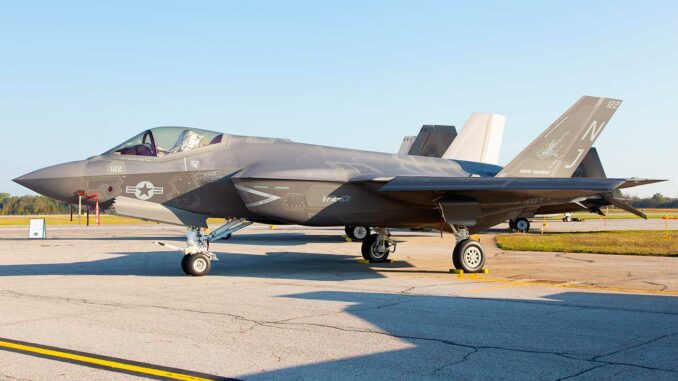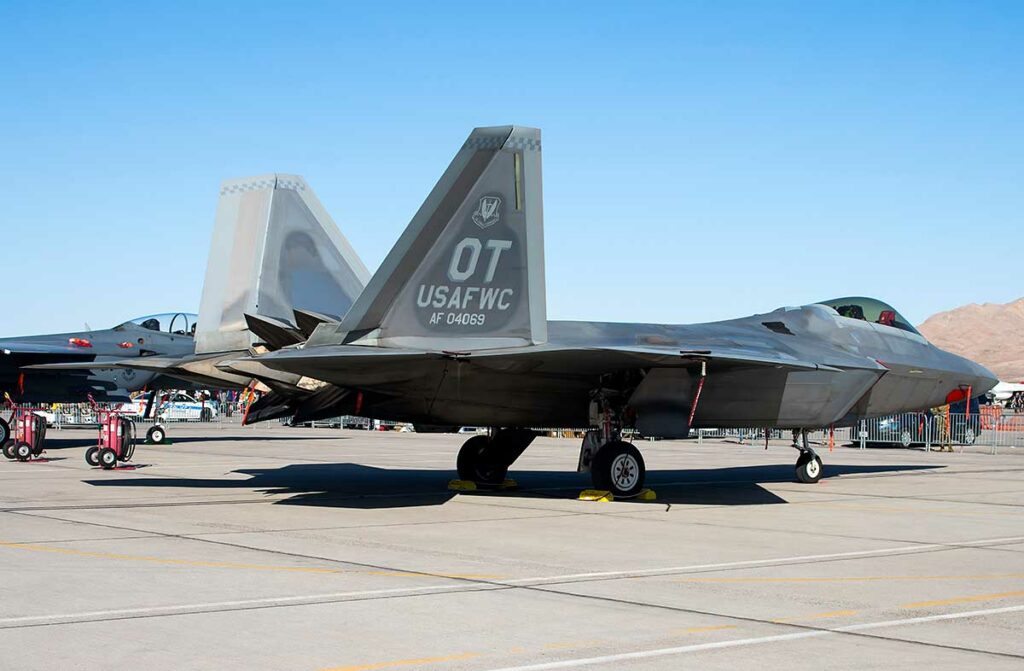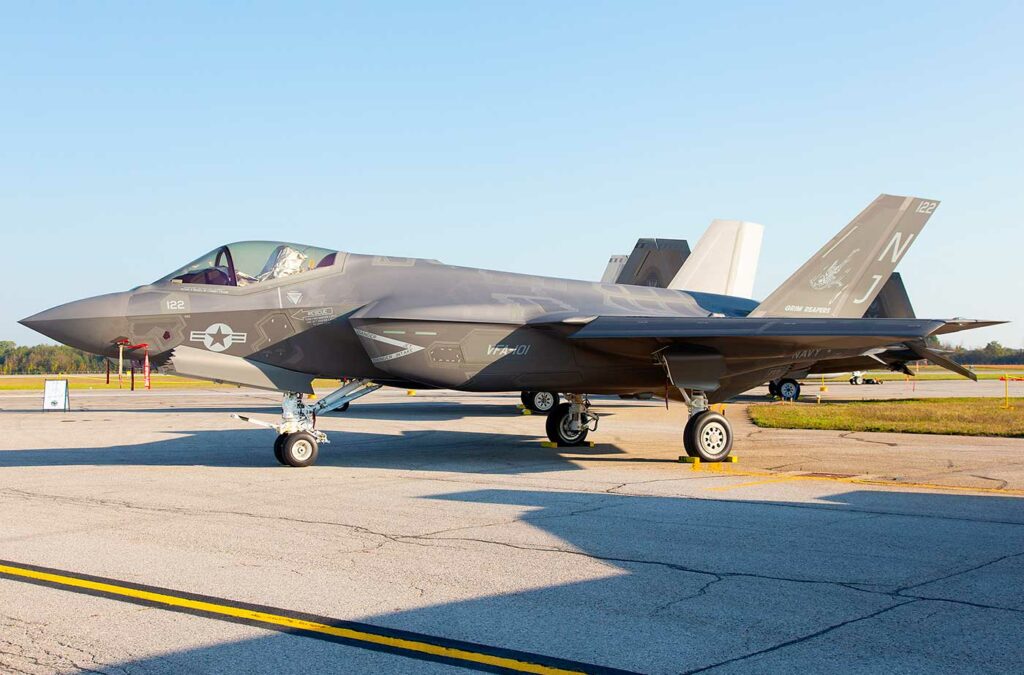
Trump announces the F-55, a future twin-engine stealth fighter, and a vast modernization program for the F-22, with no clear timetable or budget.
President Donald Trump recently stated that the United States is developing a new twin-engine stealth fighter jet, dubbed the F-55, which is intended to partially replace the F-35. This announcement is accompanied by a major modernization plan for the F-22 Raptor fleet, with an updated version named the “F-22 Super.” The central argument is based on open criticism of single-engine aircraft in high-threat areas. No specifications, budget or precise timetable have been presented, raising questions about the feasibility and strategic direction of the project. This article analyzes in detail the technical, industrial and geopolitical implications of such a program.

The F-55: towards a more enduring and resilient stealth fighter
The announcement of a twin-engine stealth fighter designated F-55 is based on explicit criticism of the F-35: its single engine. However, the F135 engine that powers the F-35 has been the subject of much debate, particularly regarding its maintenance costs and its ability to withstand damage in combat. In a contested environment, the loss of a single engine means the loss of the aircraft, which is unacceptable when facing adversaries with advanced detection networks such as China or Russia.
A twin-engine aircraft, such as the F-22, offers vital redundancy: if one engine fails, the second allows the aircraft to return to base. This increases pilot survival rates, reduces costly losses, and enhances the ability to operate far from main bases. In addition, two engines provide:
- higher cumulative thrust (>180 kN compared to 125 kN for the F-35A),
- increased payload capacity (weapons and fuel),
- greater endurance (up to 3,000 km potential range in stealth configuration, compared to 1,400 km for the F-35).
Although its specifications have not been confirmed, the F-55 project therefore appears to be aiming for an aircraft closer to the F-22 or the Russian Su-57 in terms of format, but undoubtedly equipped with modernized avionics derived from the F-35.
The estimated cost of developing a twin-engine stealth fighter from scratch is between €15 billion and €25 billion at the pre-industrial stage (R&D, prototypes), based on previous programs (F-35, B-21). This figure does not include mass production.
The revival of the F-22 Raptor: objectives, limitations, and relevance
The presidential statement also mentions a major upgrade of the F-22, in the form of an “F-22 Super”. To date, 186 F-22 units have been produced between 1997 and 2011, of which approximately 120 are in active service today. However, these aircraft have never been exported and have not undergone a complete structural upgrade in 15 years.
An ambitious modernization would involve:
- a redesign of the avionics (integration of F-35 sensors such as the AN/APG-81),
- an upgrade of the F119 engine (more than 156 kN of afterburner thrust),
- the addition of advanced data links (such as MADL),
- Discreet improvements to passive stealth (coating, air intakes).
However, the F-22 airframe has not been in production since 2011, and in 2017 Lockheed Martin estimated that it would cost €9 billion to restart the production line for just 194 additional aircraft. A major modernization program would cost around $300 to $400 million per aircraft, according to experts at the RAND Corporation.
This raises a key question: is it better to modernize an aircraft whose production line has been shut down, or to develop a new, more adaptable model? Especially since the NGAD (Next Generation Air Dominance) program launched in 2020 is already pursuing this logic with a so-called “6th generation” fighter.
Industrial and political stakes: Lockheed Martin on the front line
If the F-55 project sees the light of day, it will inevitably fall within the remit of Lockheed Martin, the historic manufacturer of the F-22 and F-35. The US military aviation industry operates with a limited number of main suppliers, and Lockheed Martin already has the infrastructure, stealth expertise, and access to critical technologies.
However, Northrop Grumman, which is involved in the B-21 Raider program and the NGAD prototypes, could claim a share of the market, particularly for sensors, active stealth, and engines (via Pratt & Whitney).
Such a program generates thousands of skilled jobs: according to the Department of Defense, the F-35 directly or indirectly employs more than 250,000 people in the United States. The announcement of an F-55 could therefore have both economic and strategic objectives, especially in an election year.
However, without a formal Request for Proposal (RFP), this announcement remains outside the US Air Force’s usual procurement process. No budget has been announced, and Congress has not yet approved anything. This may indicate short-term political will rather than a structured strategic plan.

Strategic consequences: maintaining superiority over China and Russia
The United States faces growing air competition. The Chinese Chengdu J-20, now produced at an estimated rate of 35 to 50 units per year, has evolved into a twin-engine version with WS-10C engines. It has an estimated range of 2,000 km, with partial stealth capabilities.
Russia, meanwhile, is developing the Su-57 and a lightweight stealth prototype, the Su-75 Checkmate, although operational numbers remain low. In Europe, the Rafale F4 and the future Franco-German SCAF (Future Combat Air System) are ramping up production.
In response to these developments, the United States is seeking to maintain its technological lead by developing versatile platforms capable of dominating in denied environments (anti-access/area denial). The F-55 would therefore aim to bridge the capability gap between the F-35 and the future NGAD, expected around 2030–2035.
However, such redundancy between programs—F-22 Super, F-35, NGAD, F-55—raises questions about budgetary and doctrinal consistency. The Pentagon risks diluting its investments without a clear timetable.
A political signal rather than a strategic turning point
The announcement of the F-55 and F-22 Super does not commit to any structured program at this stage. Above all, it highlights the perceived limitations of the F-35 in pure air superiority missions and the political will to respond quickly to Chinese and Russian threats. But without a budget, specifications, or planning, the real impact on US air strategy remains hypothetical.
The implementation of a twin-engine stealth fighter would be technically possible, but would require several years of development, a budget of more than €20 billion, and a clear decision by Congress. In the absence of these elements, the announcement seems to be more a matter of political communication than operational engineering.
War Wings Daily is an independant magazine.